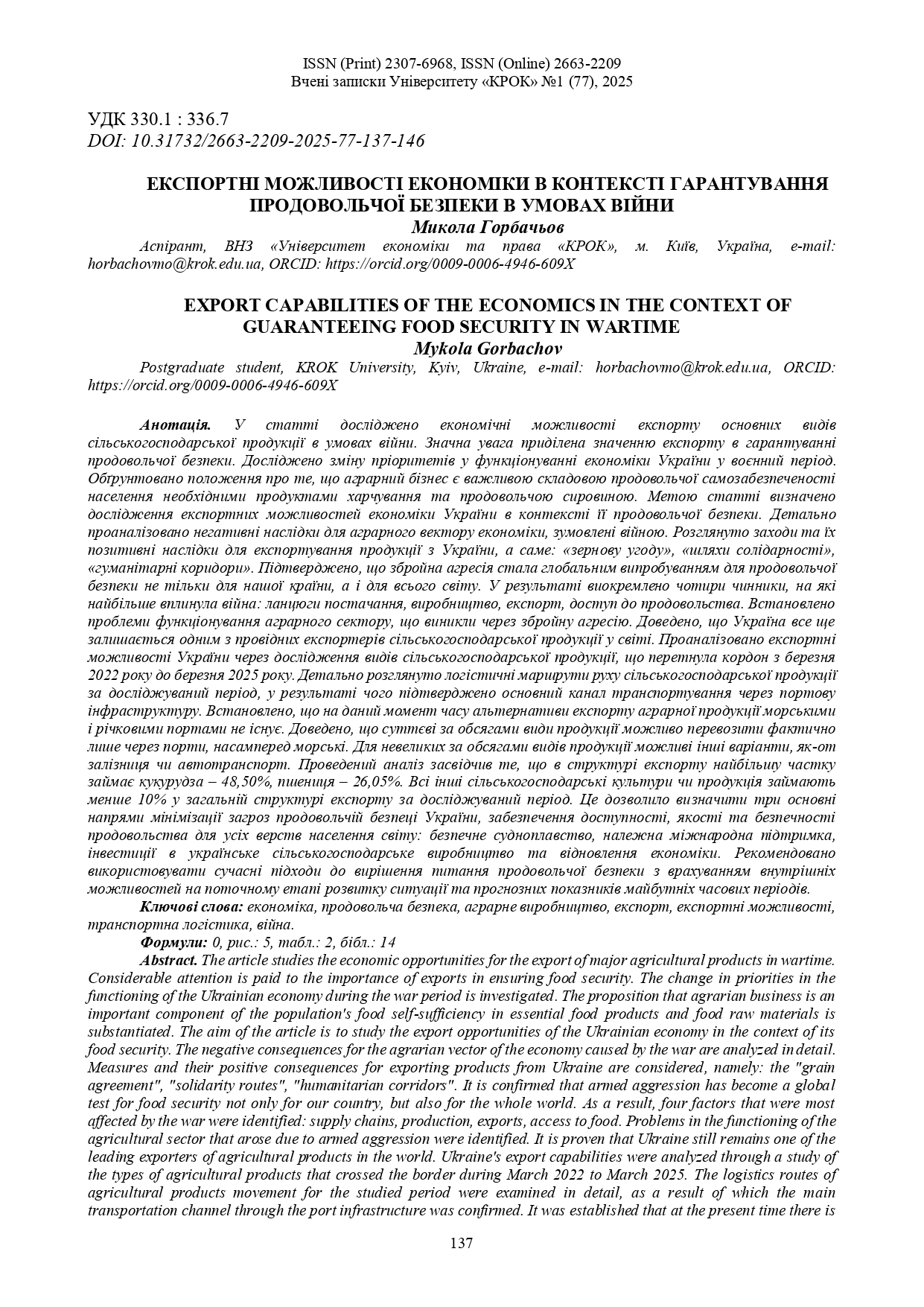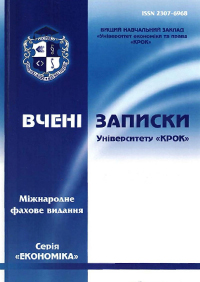EXPORT CAPABILITIES OF THE ECONOMICS IN THE CONTEXT OF GUARANTEEING FOOD SECURITY IN WARTIME
DOI:
https://doi.org/10.31732/2663-2209-2025-77-137-146Keywords:
economics, food security, agricultural production, export, export opportunities, transport logistics, warAbstract
The article studies the economic opportunities for the export of major agricultural products in wartime. Considerable attention is paid to the importance of exports in ensuring food security. The change in priorities in the functioning of the Ukrainian economy during the war period is investigated. The proposition that agrarian business is an important component of the population's food self-sufficiency in essential food products and food raw materials is substantiated. The aim of the article is to study the export opportunities of the Ukrainian economy in the context of its food security. The negative consequences for the agrarian vector of the economy caused by the war are analyzed in detail. Measures and their positive consequences for exporting products from Ukraine are considered, namely: the "grain agreement", "solidarity routes", "humanitarian corridors". It is confirmed that armed aggression has become a global test for food security not only for our country, but also for the whole world. As a result, four factors that were most affected by the war were identified: supply chains, production, exports, access to food. Problems in the functioning of the agricultural sector that arose due to armed aggression were identified. It is proven that Ukraine still remains one of the leading exporters of agricultural products in the world. Ukraine's export capabilities were analyzed through a study of the types of agricultural products that crossed the border during March 2022 to March 2025. The logistics routes of agricultural products movement for the studied period were examined in detail, as a result of which the main transportation channel through the port infrastructure was confirmed. It was established that at the present time there is no alternative to the export of agricultural products through sea and river ports. It was proved that significant types of products can actually be transported only through ports, primarily sea ones. For small types of products, other options are possible, such as railways or cargo vehicles. The analysis showed that the largest share in the export structure is occupied by corn - 48.50%, wheat - 26.05%. All other agricultural crops or products occupy less than 10% in the total export structure for the studied period. This allowed us to identify three main areas for minimizing threats to Ukraine's food security, ensuring the availability, quality and safety of food for all segments of the world's population: safe shipping, adequate international support, investments in Ukrainian agricultural production and economic recovery. It is recommended to use modern approaches to solving the issue of food security, taking into account internal capabilities at the current stage of the situation and forecast indicators for future time periods.
Downloads
References
Артеменко Л., Мариненко Н., Крамар І., Гац Л. (2023). Продовольча безпека України в умовах військової агресії: стан та перспективи. Соціально-економічні проблеми і держава, 1(28), 115-128. DOI: https://doi.org/10.33108/sepd2023.01.115
Бутіна, М. (2022). Забезпечення продовольчої безпеки в умовах воєнного стану: що передбачено законом? URL: https://ips.ligazakon.net/document/NZ221362
ІАЕ (2001). Проблеми ефективного функціонування АПК в умовах нових форм власності та господарювання: монографія: у 2-х томах / за ред. П.Т. Саблука, В.Я. Амбросова, Г.Є. Мазнєва. Київ: Ін-т аграрної економіки УААН.
Мінагро (2025). Експорт з України зернових, зернобобових та борошна. URL: https://minagro.gov.ua/napryamki/eksport-do-krain-ies/eksport-z-ukrayini-zernovih-zernobobovih-ta-boroshna
НІСД (2022). Україна та глобальна продовольча безпека в умовах війни: аналітичний огляд експертів Національного інституту стратегічних досліджень. URL: https://niss.gov.ua/news/komentari-ekspertiv/ukrayina-ta-hlobalna-prodovolcha-bezpeka-v-umovakh-viyny
Саміт (2024). Спільне комюніке з продовольчої безпеки. URL: https://www.president.gov.ua/storage/j-files-storage/01/29/53/e0bb6b4a256181b28b27cfc100927048_1725468674.pdf
Слово і діло (2024). Як за час повномасштабної війни подорожчали базові продукти. URL: https://www.slovoidilo.ua/2024/11/29/infografika/ekonomika/yak-chas-povnomasshtabnoyi-vijny-podorozhchaly-bazovi-produkty
Про внесення змін до деяких законодавчих актів України щодо створення умов для забезпечення продовольчої безпеки в умовах воєнного стану: Закон України від 24 березня 2022 року №2145-ІХ. URL: https://zakon.rada.gov.ua/laws/show/2145-20#Text
Про схвалення Стратегії продовольчої безпеки України на період до 2027 року та затвердження операційного плану заходів з її реалізації: розпорядження Кабінету Міністрів України від 23 липня 2024 р. №684-р. URL: https://zakon.rada.gov.ua/laws/show/684-2024-%D1%80#Text
Румик, І. (2020). Продовольча безпека держави: питання теорії, методології, практики: монографія. Київ: ВНЗ «Університет економіки та права «КРОК». DOI: https://doi.org/10.31732/FS
Румик, І.І,, Горбачьов, М.О. (2024). Вплив аграрного бізнесу на ринки продовольства в економічній системі. Держава, регіони, підприємництво: інформаційні, суспільно-правові, соціально-економічні аспекти розвитку: матеріали VI Міжнародної конференції (5-6 грудня 2024 р., м. Київ). Київ: Університет «КРОК», 2024. URL: https://conf.krok.edu.ua/SRE/SRE-2024/paper/view/2567
Rumyk, I. (2021). Modeling the impact of economic indicators on food security. Economics, Finance and Management Review, 2, 4-13. DOI: https://doi.org/10.36690/2674-5208-2021-2-4
Welsh, С. (2024). Russia, Ukraine, and Global Food Security: A Two-Year Assessment. CSIS. URL: https://www.csis.org/analysis/russia-ukraine-and-global-food-security-two-year-assessment
УЗА (2025). Українська зернова асоціація. Огляд ринку. Експортні показники. URL: https://uga.ua/eksportni-pokazniki/

Downloads
Published
How to Cite
Issue
Section
License

This work is licensed under a Creative Commons Attribution-NonCommercial 4.0 International License.

